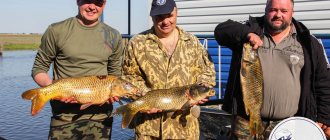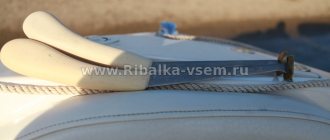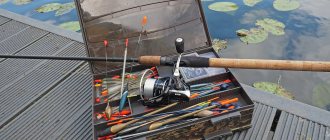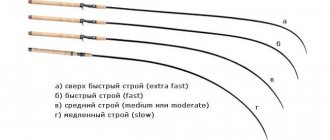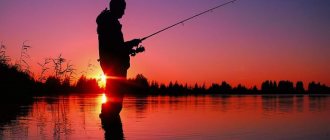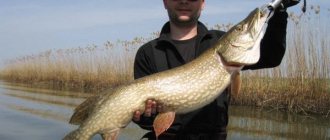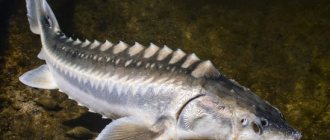The Volga is the longest river in Europe, which flows in Russia, although it is specified that a small part of the reservoir is also located in Kazakhstan.
In addition to great interest from tourists, the river also attracts with the diversity of its “water world”, which is of great interest to those who like to fish and relax in the fresh air.
Content
- 1 Description
- 2 Types of fish
- 3 Fishing 3.1 Fishing gear
- 3.2 Catching asp
- 3.3 Catching catfish
- 3.4 Catching carp
- 3.5 Zander fishing
- 3.6 Pike fishing
- 4.1 Summer fishing
Some features of catching pike with jigs in Trekhrechye
There are no difficulties with step-by-step wiring of heavy jig heads and Cheburashkas (and they will be quite heavy due to the current and depths). Even a beginner can master this fishing technique.
There is an interesting point in catching large pike in these parts. Pike, which prefers hunting from ambush, usually does not pursue its prey, but having attacked once at a length of 1-2 body lengths and missed, it loses interest in it. But in Three Rivers it often happens that a large predator begins to chase the bait and attacks it again. This behavior of pike is typical when fishing with soft baits (silicone, foam rubber), which, at the first unsuccessful grip, do not leave the predator with suspicion of deception, unlike metal spinners and wobblers. And unhurried retrieval of the jig bait with pauses predisposes the pike to a new attack. So after the first miss of a predator, be it a pike perch or a pike, do not stop retrieving - repeated bites are possible. If the strikes on the bait are sluggish and disappear one after another, you should try changing the bait or the pace of the retrieve, making longer pauses between steps, and changing the amplitude (height) of the steps.
By-catch with this method of fishing in the fall and spring in the cage includes pike perch and asp, and sometimes medium-sized catfish. So you should be prepared for any surprises.
Description
Volga Basin
Water system:
Caspian Sea.
Length:
3,530 km.
Catchment area:
1,360,000 km².
Water flow at the mouth:
7,700 m³/s.
Slope:
0.1 m/km.
Character of the current:
flat.
Tributaries:
Runa, Kud, Orekhovka, Zhukopa, Lemenka, Kocha, Bolshaya Dubenka, Malaya Dubenka, Pesochnya, Selizharovka, Bolshaya Kosha, Malaya Kosha, Malodomnya, Malaya Itomlya, Itomlya, Orcha, Tudovka, Talitsa, Mlinga, Sishka, Koksha, Dunka , Kind, Rakitnya, Khalynka, Bolshaya Locha, Slaughterhouse, Vazuza, Dragocha, Holding, Iruzha, Sergovka, Cheremoshnya, Staritsa, Nizhnyaya Staritsa, Kholokholnya, Karzhai, Ivanishki, Ulyust, Rzhavtsa, Izbrizhka, Darkness, Mezhurka, Tmaka, Tvertsa, Orsha , Inga, Black, Trestyanka, Vetlyana, Zheleznitsa, Uzola, Parasha, Zhuzhla, Pyra, Linda, Black, Khalzovka, Levinka, Oka, Vezloma, Nuzhenka, Rakhma, Vatoma, Kudma, Alferovka, Nyuzhma, Kitmar, Kerzhenets, Sundovik, Black Maza, Big Maza, Nyuzhma, Stroek, Sura, Khmelevka, Lutosha, Dorogucha, Bag, Yunga, Yunga, Small Yunga, Rutka, Arda, Sundyr, Parat, Black, Big Tsivil, Sundyrka, Mamoksha, Tair, Anish, Yalchik, Sviyaga , Kazanka, Kama.
Uren, Tushonka, Sengileika, Bolshoi Cheremshan, Sok, Samara, Chapaevka, Bezenchuk, Syzranka, Dalnyaya Chernova, Chagra, Maly Irgiz, Ilchik, Maly Mechet, Pioneer. Reservoirs:
Verkhnevolzhskoe, Ivankovskoe, Uglichskoe, Rybinskoe, Gorkovskoe, Cheboksary, Kuibyshevskoe, Saratovskoe, Volgogradskoe.
Canals:
Volga-Baltic waterway, Vyshnevolotsk system, Tikhvin system, North Dvina system, White Sea-Baltic canal, Volga-Don canal.
Bottom:
mostly sandy, there are also clayey and rocky places (including very massive stone ridges).
In areas where reservoirs back up and the flow slows down significantly, there is usually a muddy bottom overgrown with underwater vegetation. Mouth:
Caspian Sea.
At the confluence, the height of the water's edge above sea level is -28 m. Coastal landscape:
along the entire length of its route, the Volga crosses several natural zones of the European part of Russia.
In the very upper reaches it flows through swamps and spruce forests, then among the southern taiga and mixed forests. After the Rybinsk Reservoir, forests along the banks are less common; they are replaced by fields and meadows. Below Kazan, the river flows through the forest-steppe zone, which stretches approximately to Samara, and then the real steppe begins. After Volgograd it gives way to semi-desert, continuing all the way to the delta. Settlements on the banks:
Volgoverkhovye, Selizharovo, Rzhev, Zubtsov, Staritsa, Tver, Novozavidovsky, Konakovo, Korcheva, Dubna, Kimry, Kalyazin, Uglich, Myshkin, Mologa, Rybinsk, Tutaev, Konstantinovsky, Yaroslavl, Nekrasovskoye, Kostroma, Volgorechensk, Krasnoe -on-Volga, Plyos, Navoloki, Kineshma, Zavolzhsk, Yuryevets, Sokolskoye, Puchezh, Chkalovsk, Gorodets, Balakhna, Bolshoye Kozino, Nizhny Novgorod, Bor, Kstovo, Makarievo, Lyskovo, Vasilsursk, Kozmodemyansk, Cheboksary, Novocheboksarsk, Mariinsky Posad, Zvenigovo, Kozlovka, Volzhsk, Zelenodolsk, Nizhnie Vyazovye, Sviyazhsk, Vasilyevo, Kazan, Bolgar, Tetyushi, Staraya Maina, Ulyanovsk, Novoulyanovsk, Sengiley, Dimitrovgrad, Khryashchevka, Tolyatti, Zhigulevsk, Samara, Novokuybyshevsk, Oktyabrsk, Syzran, Khvalynsk, Dukhovnitskoye, Balakovo, Volsk, Marx, Saratov, Engels, Privolzhsky, Rovnoe, Kamyshin, Nikolaevsk, Dubovka, Volzhsky, Volgograd, Krasnoslobodsk, Svetly Yar, Akhtubinsk, Narimanov, Astrakhan, Red Barricades.
The Volga River is the largest river in Europe and the most abundant in Russia. This is the longest river in the world that flows into an inland body of water - the Caspian Sea. The river basin occupies an area equal to half the area of Europe. The Volga River has more than one and a half hundred tributaries - this is one of the records on the planet. On average, it takes water 37 days to travel from source to mouth, since the current speed is approximately 4 km per hour. The Volga is one of the few rivers that has its own holiday - in Russia May 20 is considered to be Volga Day.
The Volga flows through the territory of Russia, only a small branch of the Kigach goes east to the Atyrau region of the Republic of Kazakhstan. The Volga River begins in the Tver region near the village, which is called Volgoverkhovye. Here its source is a small stream, which after a few kilometers crosses the lakes - first Small, and then Bolshoi Verkhity, which give strength to the great river. About a third of the European part of Russia is washed by the waters of the Volga basin. The Volga and its tributaries flow through the territory of thirty administrative regions of Russia and one region of Kazakhstan. The mouth of the river is located in the Astrakhan region and represents the largest delta in Europe from numerous branches that flow into the Caspian Sea.
Types of fish
It is believed that the most interesting places for fishing on the Volga are reservoirs, as well as the estuary area and delta.
Conventionally, the river can be divided into 6 sections:
- The very upper reaches
- from the source to the Upper Volga lakes. There are two small lakes here - Malye Verkhity and Bolshiye Verkhity, through which the Volga flows. The river in most of this area is a shallow, slightly swampy stream, only at the confluence with Lake Sterzh (currently part of the Upper Volga Reservoir) it becomes somewhat wider and deeper. The main ichthyofauna here is made up of roach, perch and pike. - The Upper Volga from the Verkhnevolzhsky Beishlot to the Ivankovsky Reservoir
- in this section the river already has sufficient water content not only for full-fledged fishing, but also for rafting. Among the fish caught here, in addition to roach, perch and pike, are pike perch, asp, and burbot. In the upper part of the area, where the nature of the current corresponds to the foothills (there are rifts and rapids), chub and grayling, which are prohibited from fishing, live. Closer to its end of the site (approximately from Tver) carp and catfish appear. However, the population density (including fishermen) in these areas is very high. There is intense fishing pressure on the river, and poaching is also rampant. It is believed that fishing here can be successful if you know the river thoroughly, understand the habits of the fish and at the same time have good mobility - so that you can quickly change places. The quality of gear and the correct choice of bait also plays an important role. - The Upper Volga from the Ivankovskoe Reservoir dam to the Rybinsk Reservoir
- most of this section is occupied by the relatively narrow, but very extended and quite deep Uglich Reservoir (actually starting from the Ivankovskoe Reservoir dam - in the city of Dubna). Fishing in this reservoir is interesting primarily in terms of catching predators - pike perch (which reaches decent sizes), bersh, perch, catfish, pike and burbot. Among the “peaceful” fish, the most commonly caught are ruffe, bleak, roach, bream, and silver bream. Other species are also found in the reservoir - gudgeon, dace, chub, ide, asp, sabrefish, podust, bluefish, tench, silver carp, but they are somewhat less common in fishermen's catches. The section of the river after the Uglich dam is considered the Volga Bay of the Rybinsk Reservoir - new species of fish characteristic of this reservoir may appear here: sprat, vendace, peled, smelt (including its small form - smelt), river eel. - Upper Volga from the dam of the Rybinsk Reservoir to the Gorky Reservoir
- fishing in this section is in many ways similar to that upstream - in the previous sections. However, the river here is noticeably fuller - fish species such as pike perch, carp and catfish are caught somewhat more often than higher up. Some representatives of sturgeon, in particular sterlet, can also be found here. - Middle and Lower Volga
- from the dam of the Gorky Reservoir to the Volgograd Reservoir. Quite a long section - more than a thousand kilometers long. The river on it is actually a grandiose cascade of large artificial reservoirs. Here are the Cheboksary, Kuibyshev, Saratov and Volgograd reservoirs. The ichthyofauna of these places is in many ways similar to that observed upstream; new species include some representatives of gobies, nelma, herring, grass carp and silver carp. The same can be said about fishing - in all reservoirs, most often, fishermen’s catches contain a “standard” set - perch, borsch, pike perch, pike, roach, bream, carp, catfish. - Lower Volga (mouth area)
- from the dam of the Volgograd Reservoir - to the place where it flows into the Caspian Sea. Here the river is divided into several channels, the largest of which are considered independent watercourses and have their own names, for example the Akhtuba and Buzan channels. This area, together with the delta located below, is considered the most interesting in terms of fishing. Here are the most favorable conditions for ichthyofauna and a good food supply. There are a lot of fish in these places, they fatten up quite quickly and reach a decent size. Among Russian fishermen, the section of the Volga from Volgograd to Astrakhan is very popular; thousands of amateurs from other regions of the country come here every year. Most often, carp, asp, catfish, bream, pike, pike perch, perch, rudd, sabrefish, roach and others are caught here. In addition to freshwater species, there are also marine species that enter the delta and rise some distance upstream, for example, herring and gobies. Sturgeon are also found here, and Caspian salmon (a type of brown trout) also enter the river during spawning, but catching these fish is prohibited.
Fishing and hunting on the Volga and Akhtuba
The Volga-Akhtuba floodplain is the space between the Volga and Akhtuba, crossed by numerous channels and old rivers; The width of the spills within this floodplain ranges from 10 to 30 km. A section of the Volga Valley that has preserved its natural structure.
The Volga-Akhtuba floodplain begins immediately behind the Volzhskaya hydroelectric station, next to which Akhtuba separates from the Volga. Thus, on the one hand, the Volga-Akhtuba floodplain is limited by the Volga River, on the other, by Akhtuba. And such a strip several tens of kilometers wide stretches the floodplain from Volgograd to Astrakhan (about 450 kilometers), surrounded on all sides by endless steppes.
The main part of the floodplain is located in the Astrakhan region, a small (initial) part is in the Volgograd region (in this area, the Volgo-Akhtubinskaya floodplain natural park was created in 2000). The area of floodplain land suitable for agricultural use is about 700 thousand hectares, the total area of the floodplain (including reservoirs) is about 2 million hectares.
A favorable climate (abundance of heat and moisture) contributes to the effective cultivation of a large number of crops in the floodplain: tomatoes, cucumbers, watermelons, apples, grapes, pears, apricots, potatoes.
The floodplain is also famous for its abundance of fish and wildlife (especially birds). Numerous lakes and watercourses, heavily overgrown with reeds, provide shelter for the birds of the wetland complex. Located on the so-called “ecological channels”, they serve as a resting and feeding place for many, including rare migrant birds nesting in the European North, the Urals, and Western Siberia. A significant part of them are rare, classified as endangered or endangered.
The flora of the Volga-Akhtuba floodplain is also rich - here you can see dense thickets of willow, oak and ash trees. The combination of numerous lakes, eriks and channels, green tracts of floodplain oak forests and water meadows, pleasing the eye with their forbs, create its unique appearance and attractiveness of the Volga-Akhtuba floodplain.
The Volga-Akhtuba floodplain also has its own archaeological, historical and cultural sites: Bronze Age burials in the area of the Cherepashki farm. A monument in the village of Yama, where the headquarters of the South-Eastern Front was located during the Battle of Stalingrad, and a monument in the village of Tumak, where the fleet base was located.
The reservoirs of Astrakhan abound with a wide variety of fish. Of the 59 species, the most numerous are: catfish, carp, asp, pike, perch, bream, crucian carp. The region is especially popular among connoisseurs of trophy fishing. Catfish up to 40 kg, carp up to 25 kg, asp up to 10 kg, bream - 5 kg, pike perch and pike - more than 20 kg - all this is not uncommon here.
Fisherman's calendar by type of fish
Fish | Fishing period | Where to fish | How to catch |
| Som | March-November. Peak fishing: August-September | Catfish 1-5 kg - near the base and on the eriks. Trophy - in pits, caught with bottom tackle | Rod - feeder, carp (catfish) with a test from 100 g Reel - spinning or multiplier, power 3500 - 10000 Line - main braided or mono, breaking load 30 kg Nozzle - bunch of worms (dung), cut fish, frog, vibrotail, wobbler |
| Carp | June-October. Peak fishing: August-September | Trophy carp (up to 25 kg) - from a boat on edges, holes, snags. On eriks (up to 5 kg) - on bottom tackle or fishing rod | Rod - feeder, carp (catfish) with a test from 100 g Reel - spinning or multiplier, power 3500 - 10000 Line - main braided or mono, breaking load 30 kg Nozzle - dung worm, cake, corn, boilie |
| Bream | April-May July-November | 1.5 - 5 kg: edges, holes, snags. 1 - 1.5 kg: eriki, pits | The rod is a feeder, on eriks it is a fishing rod. Any bottom tackle. The reel is inertialess. Fishing line - 0.3-0.5 mm. Nozzle - dung worm, corn |
| Zander | March-April June-January | 1-6 kg: edges, pits | Rod - spinning rod, with dough up to 30-40 g Reel - power 2000-2500 Line - any, load up to 10 kg Attachment - live bait, wobbler, vibrotail |
| Pike | March-November | On Eriks | Rod - spinning, with a cast of up to 30-40 Reel - power 2000-2500 Line - any, load up to 10 kg Attachment - spinners, spinners, castmaster |
| Asp | May-November | Near the base | Rod - spinning rod, with dough up to 30-40 g Reel - power 2000-2500 Line - any, load up to 10 kg Nozzle - castmaster, wobbler |
| Perch silver bream sabre | Always | Everywhere | Anyway |
Fishing
Volga river
Tackle for fishing
Gear for fishing on the Volga must be selected based on what kind of fish you are going to catch. As a rule, the selection of fishing tackle for a particular fish differs in the length of the rod, the action of the rod, the multiplier reel, the spinning reel, etc., the braided or monofilament fishing line of different diameters, the baits used: wobblers, poppers, foam rubber, spinners, etc. . Let's figure out what gear is needed for fishing on the Volga for asp, what gear to catch catfish on the Volga, how to choose gear for fishing for carp, and also what gear for catching pike and pike perch to use when fishing on the Volga.
Asp fishing
Tackle for asp
Tackle for catching asp should be selected based on the behavioral characteristics of this fish. Asp is a very cautious fish and catching asp on the Volga occurs with the help of long casting. It follows from this that the best tackle for catching asp on the Volga will be a spinning rod with a rod length of 3 to 3.3 meters. The action of the gear for asp is preferable from medium to medium-fast, the test of the cast bait is from 10 to 35 g. A monofilament line with a diameter of approximately 0.2-0.22 mm is suitable for catching asp on the Volga, but if you are a fan of braided line, then use braided line with a diameter of up to 0.13 mm. The tackle for an asp definitely needs to be set up and the clutch adjusted, since the asp behaves actively when fishing. As for the reel, a spinning reel of the 3000-3500 series from Daiwa and Shimano is suitable. When choosing gear for asp fishing, keep in mind that the asp often bites when the bait is retrieved super-fast, so pay attention to the high gear ratio of the asp reel.
The best baits for catching asp
The best lures for asp fishing on the Volga are Kastmasters weighing from 14 to 27 grams; color can affect the bite; it is preferable to use wobblers with an orange or blue stripe for asp fishing on the Volga. The asp bites on spoons, jigs, and rotating spoons. The best bait for asp when fishing on boilers is surface wobblers.
Catching catfish
Catfish fishing gear
Catching catfish while fishing on the Volga is the dream of every fisherman.
This Volga giant needs special gear to catch it. If you plan to catch catfish with a spinning rod from a boat, then you will need a rod with a fast action and a length of 2.4-2.7 m, a weight test of 40-80 or 50-100 g. A braid with a diameter of 0.2–0.3 mm will allow you to avoid breakage if you need to force fishing. A spinning rod for catching catfish must be equipped with a Shimano Tecota 500 class multiplier reel. The equipment for catching catfish with a spinning rod can be used with a jig. It is excellent to catch catfish when fishing on the Volga by trolling. Here, however, one should distinguish between deep-sea trolling for catfish in pits and riverbed edges; and shallow-water trolling for catfish on the rifts, where catfish come out in the second half of summer to hunt for saberfish. You can also catch catfish while fishing on the Volga in a plumb line, using a short, powerful rod up to 2.1 m long with a cast of 100 g, which should be equipped with a powerful multiplier reel. Fishing on the Volga
The best bait for catching catfish
The best lures for catching catfish by trolling in deep areas are Storm Deep Thunder wobblers with a length of 11 to 15 cm (immersion depth 5.5 - 9 meters), floating wobblers MANN'S and Halco (immersion depth 7 to 9 meters) are also suitable. Wobblers for catfish for depths from 10 to 13 m are MANN'S and RIVER 2 SEA class 30+. Fishing for catfish in July-August on shallow reaches and riffles will require the use of wobblers with a diving depth of 1.5 to 2.5 meters, as an option - the universal wobbler Storm Hot'n Tot, suitable for catching any predatory fish on the Volga. In principle, to catch catfish on the Volga in shallow water, you can use any floating wobbler equipped with a rattle and reliable tees. Catching catfish on the Volga with a jig involves using a sinker head weighing from 40 to 80 grams to feel the retrieve and the bait touching the bottom, since catfish fishing is done in holes and at great depths with a noticeable current. It is better to catch catfish using such baits as: large vibrating tails, large twisters, foam fish up to 15 cm long. It is extremely important when catching catfish to use a metal leash so that the brush made of catfish teeth does not fray the braid during long-term fishing. Remember, the main thing when catching catfish on the Volga is the strength of all elements of fishing gear.
Catching carp
Tackle for catching carp
Catching carp on the Volga requires the use of durable gear. Fishing for carp, a strong and cunning fish, is always a struggle. Fishing for carp brings a lot of thrills, so the tackle should be as reliable as possible. Professionals use carp fishing gear for carp fishing: carp rods, carp reels and a stand with an electric bite alarm. Of course, gear for carp is expensive, so if you really want to try to catch carp, then a converted spinning rod with a dough of 40-80 grams and a length of 2.7-3.3 meters is suitable for catching carp on bottom gear. It is advisable to use a reel for carp from Shimano with a Bait Runner system of the 6000-10000 series, but you can also get by with Daiwa reels of the 4000-5000 series. For carp, a braided line with a diameter of 0.2-0.3 mm is preferable, but monofilament with a diameter of 0.4-0.5 mm can also be used. Monofilament line fends off jerks much better when fishing for carp. Also, for fishing for carp on the Volga, you will need weighty sinkers for bottom equipment and durable hooks for catching carp weighing from 4 kg.
The best baits for catching carp
The best baits for carp are boilies and barley shell meat. To improve the bite when fishing for carp on the Volga, you can use carp bait.
Fishing for pike perch
Tackle for catching pike perch with jig
Fishing on the Volga for pike perch is one of the most exciting, especially since the methods of catching pike perch are varied. Let's figure out what gear is needed for fishing for pike perch. To catch pike perch with a jig, you will need a fast rod 2.7-3 m long with a cast of 15-40 or 20-50 g. The main weight of jig heads for catching pike perch on riverbed edges and dumps is in the range from 35 to 50 grams. As for catching other predatory fish on the Volga, for fishing for pike perch it is better to use braided fishing line with a diameter of 0.15-0.19 mm. A reel for pike perch would be appropriate from the 3000-3500 series from Shimano or Daiwa. This condition will allow you to combine fishing for pike perch with fishing for small catfish on the Volga.
The best lures for catching pike perch
The best baits for pike perch on the Volga are foam rubber fish, vibrotails and twisters equipped with doubles or tees. The preferred bait color for pike perch is green and fluorescent green. It takes pike perch well and baits of orange and yellow shades. If you plan to catch pike perch in snags, choose foam rubber with hooks pressed tightly to the body or twisters on an offset hook with a recessed sting as bait. The pike perch has a hard mouth, so when biting it easily breaks through the silicone, exposing the hook tip.
Tackle for catching pike perch by trolling, catching pike perch on the track
The gear for catching pike perch by trolling as pike perch on the Volga is almost identical to the gear for catching catfish with a spinning rod, so the recommendations for spinning rod, reel, fishing line and wobblers are similar to those we gave above in relation to catching catfish.
The best lures for catching pike perch
The best lures for catching pike perch by trolling on the Volga are wobblers of different colors, depending on the time of year chosen for fishing on the Volga: in the spring, pike perch is caught on wobblers with a natural color that imitates carp fish - a dark back, a white belly and silvery sides; In summer, pike perch are perfectly caught using wobblers of greenish shades, for example: plain green and green with transverse stripes for perch. Another universal option is the coloring of the Red Head wobbler - red head, white body. In addition to pike perch, pike are excellent fish for this coloration. With a wobbler up to 15 cm long you can catch a luxurious trophy specimen of pike perch on the Volga. For catching pike perch at a depth of 10-13 meters, wobblers from MANN'S Magnum Stretch 30+ and RIVER2SEA downsider minnow 200f are suitable. But just in case, take slightly smaller wobblers with an elongated shape when fishing. In some cases, biting on a smaller wobbler turns out to be more interesting. Also, for fishing on the Volga, it is recommended to use wobblers from the manufacturer Halco, which are used not only by pike perch, but also by catfish.
Pike fishing
Fishing on the Volga
Tackle for pike fishing
Pike fishing on the Volga is good in the cool season; in summer the pike is a little bit fishy and to catch it you will have to use the best pike tackle. More often in the summer they catch pike not on the river itself, but in lakes and eriks, near thickets of grass. Therefore, when choosing gear for catching pike on the Volga, choose a rod 2.7 meters long with a test weight of 10-30 g; it is advisable to choose a medium-fast action for pike, this will allow you to catch pike with both floating wobblers and jig baits. A reel for pike fishing is suitable for a spinning reel of the 3000 series. A metal leash is required when fishing so as not to lose your favorite wobblers and spinners when fishing for pike. Of course, to catch pike on the Volga, use strong and elastic braid with a diameter of up to 0.13 mm.
The best lures for pike fishing
The best baits for shuka are floating wobblers with a diving depth of up to 3 meters and a size of up to 13 cm. In lakes overgrown with grass, you can use poppers and spinnerbaits. Slugs and Texas rigs work well on toadstools. You can use non-snagging Rapala Minnow Spoon spinners, as well as Mepps and Daiwa spinners converted to non-snagging spinners. Homemade non-hook fishing gear is a vivid example when DIY fishing gear gives tangible results when fishing in the grass.
Pike fishing in autumn
Autumn is considered the best period for catching a predator.
In September, pike are usually in shallow water. There is still a lot of food in the water, she is just getting ready to feed and is not very active. At this time, it is best to catch predators with large, brightly colored baits, such as wobblers and spinners.
From the end of September to November, pike have a zhor. By this time, the water has completely cooled down and the temperature drops, and the predator strives to build up a thick layer of subcutaneous fat in order to survive the winter calmly. It bites on any artificial bait, be it a spinner, a twister or a vibrotail. It is best to start fishing during this period.
In November, the activity of the fish gradually decreases, and it descends to depths from where it is not easy to catch it, although live bait or jig are capable of this.
Fishing methods
Two types of fishing are considered the most famous and effective: trolling and casting. To fish for pike in the first way, you need to get on a boat and go to the selected part of the reservoir, and then cast the bait and swim slowly. Then the bait will be constantly in motion and thereby attract the predator
When fishing for pike by casting, you need to force the bait to move using a fishing line or rod, it depends on the bait itself. For example, twitching involves twitching the tip of a spinning rod and your own play of bait.
How to properly fish for a predator
To catch pike, you need to know how to do it. The toothy predator does not respond to standard fishing methods and requires special techniques. Here she is:
- When biting, the pike must be hooked immediately. In order for the fish to hook for sure, this must be done sharply and strongly, since the predator has a powerful mouth that is difficult to break.
- After hooking, just don’t let the pike sink to the bottom and wait.
- In five to seven minutes of resistance, the predator will completely weaken.
- As soon as she gets tired of squirming, start pulling her out. To do this, slowly and carefully lift the spinning rod and then lower it sharply so that the line loosens and can be easily wound onto the reel.
- Repeat step four until the fish is very close. After that, get it out with a net or leash.
Seasonal fishing
They fish on the Volga all year round, and there are practically no obvious declines in the behavior of the fish. However, there are also some peculiarities dictated by local climate conditions.
Summer fishing
The summer fishing season here is considered to be the period from the end of June to mid-September. Different types of fish are caught with different types of gear. To be more precise, quite decent bream are caught on the bottom, with float tackle you can catch plenty of roach, carp, carp, silver bream, sabrefish, and spinning rods often catch large pike and catfish. Catching catfish here is especially exciting, since it is unlikely that anywhere else you will have the opportunity to try your luck in catching a real giant, whose weight reaches 100 kilograms. There is an opportunity to try out such gear as kwok.
Autumn fishing
In autumn, fishing for trophy predators is very effective here. First of all, you need to look for it in deep-water snags. Pike perch is very active, many come here specifically for it, since the bite of this fish reaches its peak in late autumn. The weight of individual fish can reach 10-12 kilograms, which is, in fact, very rare for pike perch. And thanks to the vast expanse of water, trolling fishing becomes especially important in the hunt for large predators. Peaceful fish species are also successfully caught, especially for carp, which continues to bite almost the very first ice.
Winter fishing
Fishing on the Volga River
If we talk about winter fishing, then the ice fishing season begins here much later than in most other regions and for some time the river remains free in places, and in some places ice forms, which, however, is not yet strong enough. The best bite here is observed on the first and last ice; in the middle of winter the fish are not so active, but continue to be caught. Roach, bream and perch are caught well with jig tackle, and pike and pike perch are caught with jigs. However, you should not forget that the weather, especially in the Astrakhan region, can be unstable, so winter fishing here requires special attention and attention.
Spring fishing
Active spring fishing begins in March. A period is coming from which many are trying to make the most of it, going with a spinning rod to the bays in search of pike and asp; the active movement of pike perch begins, which is mainly caught with jig tackle. Roach and rudd are good for catching on bottoms. Areas where numerous eriks and lakes adjoin the river become objects of increased attention of fishermen, since this is where active pre- and post-spawning fishing takes place. Schools of roach also head here, without which many fishermen simply cannot imagine Volga fishing.
Downstream
If you think about where people live with tents on the Volga, the places in Astrakhan are the coolest. But here’s the plus: everything here seems to have been created specifically for fishermen.
It is best to take a car and your own boat. The width of the Volga in this place is more than 2 kilometers. In addition, there are very beautiful panoramas here. It is also recommended to take a camera with you. Especially if you sail on a boat, the pictures turn out great. In summer the weather is warm and most often sunny. That's why people come here to sunbathe.
Best fishing spots
The lower reaches and delta of the river are considered the most attractive, regardless of the time of year. This is where most fishermen flock, fortunately there is a place to stay - a huge number of fishing bases have been built along the banks. If we talk about the delta, then this is the area where numerous branches, small rivers and channels are separated from the main channel of the Volga, forming a fairly large body of water. The best time for fishing here is spring and summer, when numerous holes open and the channels and shallow waters are simply teeming with fish.
As for the lower part of the river, here the Kama and many other rivers flow into the Volga, also attractive to fishermen. In terms of fishing, it is worth especially noting the lakes and eriks of the Volga-Akhtuba floodplain.
In general, when choosing promising places for local fishing, you should proceed, first of all, from some distance from major roads and populated areas, the presence of rifts and holes - if you are going on trophy fishing and, of course, the presence of islands, backwaters and channels, which will only contribute to productive fishing.
The Volga is also notable for its shallow areas, which can extend for many kilometers. It is worth saying that such places are most preferable for catching pike and perch, which often ambush in grassy areas. And on numerous dumps and spits there is almost always bream.
Seasonal features of fishing on Akhtuba
Fishing in spring
March
In March, on Akhtuba, due to the low water temperature, the fish are located on the deep edges, not far from the pits and are caught mainly with jig baits - vibrotails and twisters, as well as with rotating spoons with a weight head and the vertical lure method.
You need to fish across the edge, at the exit from the pits, on an underwater spit, with a stepped retrieve and a pause of about one or two seconds. In bays and lakes, perch can be caught using lures.
White bream, roach, roach, and silver bream bite on the worm.
Bream is caught with a worm using a bottom bait.
April
Fishing in April in terms of fishing technique is not much different from “March”, especially at the beginning of the month.
The asp has zhor - from the first days of April. Lures for asp - oscillating and rotating spoons, vibrating tails, twisters, wobblers.
Pike on lakes stand right in front of the shore.
Carp begins to be caught with bottom tackle from mid-April in holes with reverse currents and snags, as well as on clay edges under steep ravines. Bait - earthworms, pearl barley, cake, boilies with the smell of fish or krill.
With warming and rising water levels, white fish go to the reaches to spawn, followed by predators: pike perch and catfish. This is a good time for trolling (“Russian track”).
The catfish goes jigging at the exit of the pits, sometimes hunting in the reaches. The main baits are jigs, but spinners with a weight head, wobblers also give their results.
May
In May, the same fishing techniques are used on Akhtuba as at the end of April. The May holidays are a great time to catch white fish. The fish go to places with a quiet current - to lakes or backwaters.
Carp are caught using hollow water using float gear in ilmens and bays. There is no ban on amateur fishing during the spawning season in the Astrakhan region.
Fishing in summer
June
Fishing on Akhtuba in June is excellent, but midges... Usually the midge begins at the end of May (25-27th) and ends by June 25-27. Naturally, life in the Astrakhan region does not stop because of midges. It is at the end of May and June that fishing cooperatives engage in industrial fishing.
For local amateur fishermen, June is the time to harvest roach and herring.
July August
Heat up to 40 degrees or more. Asp takes on the breaker streams under the steep yars, among fallen trees and snags.
Pike-perch does not like heat; it is caught at night on a bottom with live bait, thrown from a sand spit onto a dump in the depths.
Pike - at the exit from the bays, closer to the grass, in slow waters. By the beginning of July, the water level in the Akhtuba River drops.
There are a lot of saberfish on the sand spits.
The catfish follows her out of the pits and onto the riffles. Catfish fishing by trolling is used all summer.
Under steep banks, in pits with snags, on reaches, in backwaters and bays - wherever there are a lot of shells: pearl barley and dressena - carp are caught.
Fishing in autumn
September
Fishing on Akhtuba in September has its own characteristics. Nights on the Lower Volga become cool.
Pike perch and asp are starting to bite better and better.
After 15-20 numbers, the carp usually moves to deep holes with snags.
The period of catching catfish on stretches and rifts is ending - the catfish moves closer to the pits. Sheer lure - gives excellent results until the very end of the season. There are catfish, pike perch and large pike.
On sandy reaches with a strong current and a depth of about 3 meters, large bream is caught using bottom tackle.
October November
October and November on Akhtuba are the best time for fishing on the deep edges; pike perch and bersh live here.
In October, on the rifts and rip currents, the asp gets zhor.
Catfish are caught in the holes with vertical spoons.
Under steep ravines in deep places with a clay bottom, carp take the carp from the snags for barley shells and earthworms.
Fishing in winter
December-March
Winter fishing is not inferior to summer and autumn in terms of excitement and trophies. In open water, winter spinning enthusiasts hunt for pike perch, pike perch, and pike perch.
According to observations from the Kharabala weather station over 50 years, the average monthly temperature in this area was:
- in December - minus 4.80;
- in January - minus 5.80;
- in February - minus 8.90,
- in March - minus 10.
In the areas of fishing bases, the current is quite fast and the Akhtuba River does not freeze every year, however, on the adjacent eriks, ilmens, backwaters, and the Ashuluk and Kharabalyk rivers, winter fishing is, as a rule, guaranteed. Pike perch, pike, perch, silver bream, roach are the main winter trophies. By the way, in winter they hunt pheasant, partridge, wolf, hare, fox, and raccoon.
The Akhtuba River flows through a strip of steppes and semi-deserts. The banks are covered with willows and bushes. Oak and other deciduous trees are occasionally found. In some places, even a short distance from the river, semi-deserts begin with real dunes and camel thorns.
The fauna consists of wild boars, wolves, raccoon dogs, jungle cats, steppe foxes, and various rodents. You can meet an otter, a mink, and a muskrat.
Several species of snakes live in the Volga-Akhtuba floodplain. Poisonous snakes are found only in steppe and semi-desert regions. The Akhtuba River, its channels and eriks are interconnected, which makes it possible to easily change fishing spots on any type of boat. There are many sandy beaches on rivers and streams where you can swim in clean, clear water and sunbathe.
It is impossible to imagine fishing on Akhtuba without the famous Mangut or Kriushi. Its length is about 10 km. The river is very deep and has a strong current. The banks are high and steep. On Mangut, carp are caught under ravines, of which there are a great many here. Somov is in whirlpools, the largest is located 1.5 km from the source. Pike perch takes almost the entire length of the channel. Asp is found in Akhtuba, Mantuga, Kharabalyk, Ashuluk everywhere in fast water.
